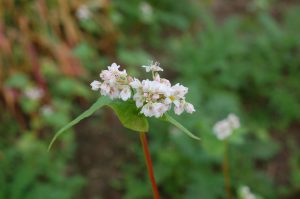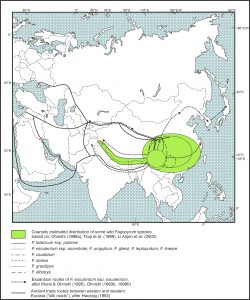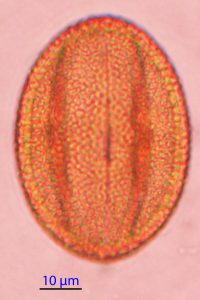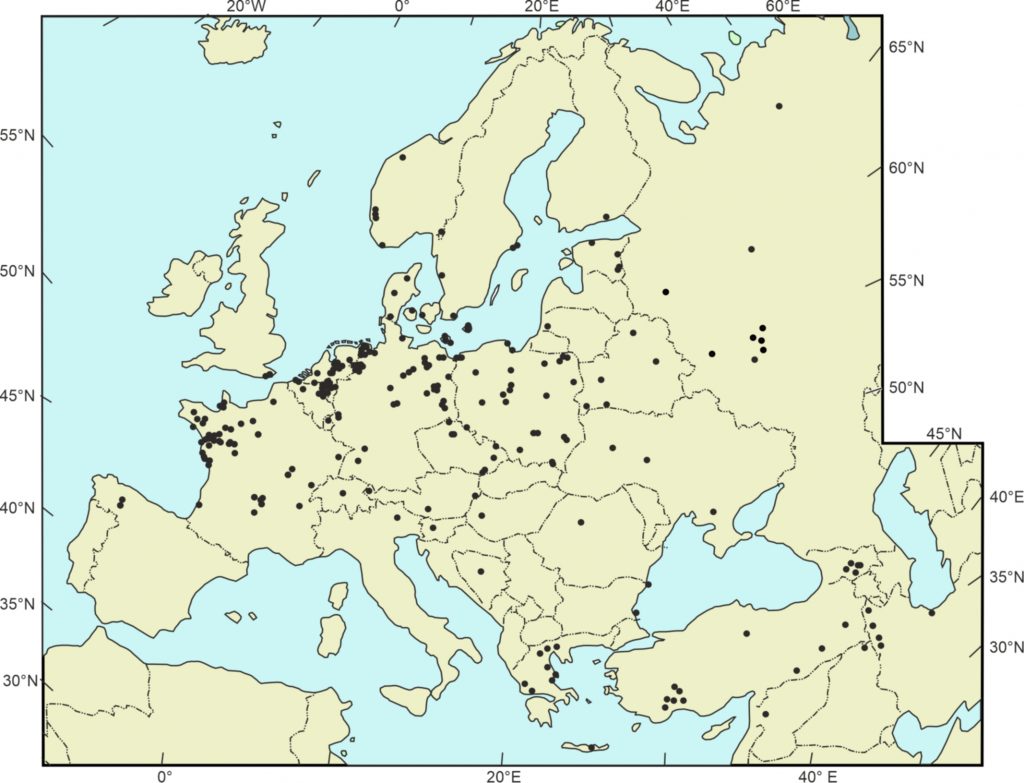Pollen and macrofossils attributable to Fagopyrum in western Eurasia prior to the late Medieval: an intercontinental mystery
The widespread perception that buckwheat (Fagopyrum esculentum) did not occur in Europe prior to the Late Medieval is challenged by numerous pollen and macrofossil finds in deposits from earlier periods. We traced some 250 records from western Eurasia with pollen and macrofossils assignable to Fagopyrum in (often much) earlier time-slices. We assume that many more finds have never been reported under the motto “it cannot be, thus it should not be”: we know of several scientists who deliberately concealed their finds for fear of ridicule.
The clear morphological characteristics of the pollen make a large-scale misidentification unlikely. The numbers of pollen grains encountered is generally low and therefore researchers are tempted to attribute their finds to contamination. Except for some clear cases, however, the majority of the finds does not show any indication of contamination (although it cannot be ruled-out). A comparison of pollen ascribable to buckwheat with that of Aesculus, a tree taxon that did not occur outside SE Europe prior to the 16th century CE, show two distinctly different patterns: in the case of contamination, the trends in both types would have been identical or at least similar for the complete Holocene. This indicates that contamination is not a major factor. Furthermore, if all observations were unreliable, it would imply a major careless work-style in many European palynological laboratories.
 Fagopyrum flowers (photo: Hans Joosten)
Fagopyrum flowers (photo: Hans Joosten)
The genus Fagopyrum evolved in southern China and – with only one exception – the 20+ known wild species are restricted to that region. Cultivation of Fagopyrum esculentum ssp. ancestrale (and its subsequent descendant F. esculentum ssp. esculentum) started probably in eastern Tibet, but the date is not yet clear. Genetic studies have demonstrated that the European populations of Fagopyrum esculentum descend from a cultivation centre in northern China and expanded westward along the ancient trade routes commonly known as “Silk Streets”. Archaeological sources indicate that already around 4000 cal yr BP trade in Eurasia had proceeded to a level that continuous exchange of goods and techniques between China and the Mediterranean took place. Theoretically, thus, cultivated buckwheat may have been present in western Eurasia since this time. However, if buckwheat was in fact cultivated there, it can only have been on a small scale.
 Occurrence of wild Fagopyrum species in eastern Asia and expansion routes of cultivated F. esculentum ssp. esculentum
Occurrence of wild Fagopyrum species in eastern Asia and expansion routes of cultivated F. esculentum ssp. esculentum
A bridge between East and West may have been formed by the area of Ukraine, where the Scythians are reported to have grown buckwheat since 800 BCE, and who are known to have exported great amounts of cereals to the ancient Greek and Celtic realms. However, the finds from Scythian archaeological monuments are highly ambiguous and cultivation can – if at all – also only have been on a small scale. Only for the Roman period and the Early/High Medieval we feel there is sufficient evidence (both pollen and macrofossils) for the conclusion that buckwheat was widely cultivated in Europe during these times, i.e. up to 1400 years earlier than generally assumed. Large-scale cultivation, however, only started after the Medieval.
 Pollen grains of Fagopyrum esculentum, from the pollen reference collection of the State Museum of natural History Karlsruhe (photo: Pim de Klerk)
Pollen grains of Fagopyrum esculentum, from the pollen reference collection of the State Museum of natural History Karlsruhe (photo: Pim de Klerk)
Another hypothesis is that the European finds result from long-distance transport of pollen of Oxygonum species or Harpagocarpus snowdenii/Fagopyrum snowdeniifrom the African continent. To evaluate this possibility, we inspected the pollen diagrams in the African Pollen Database (APD) and found that pollen attributable to these taxa have only been found incidentally in southern Africa. If these pollen types are hardly present in the African pollen rain, it is very unlikely that such pollen grains reached Europe.
 Palaeoecologically studied sites from Western Eurasia with pollen or macrofossils attributable to Fagopyrum dating before the late Medieval.
Palaeoecologically studied sites from Western Eurasia with pollen or macrofossils attributable to Fagopyrum dating before the late Medieval.
Interestingly, pollen grains attributable to buckwheat have also been found in Weichselian Pleniglacial and Lateglacial deposits in western Eurasia, for which only wild Fagopyrum species can have been responsible. From an ecological viewpoint, Fagopyrum may very well have occurred in Weichselian steppe vegetation. The example of the African F. snowdenii proves that not all species of the genus remained restricted to the southern Chinese realm, but that at least one taxon has migrated westward across the entire Asian continent (unless it was dispersed by migrating birds). We postulate, therefore, that a wild Fagopyrum species may have occurred widespread in Eurasia prior to the Holocene and became extinct afterwards. However, we have no hard evidence for this.
Hopefully the scientific community will keep an open eye for the Fagopyrum mystery to be solved.
This research was carried out in close cooperation with Hans Joosten and John Couwenberg
Video: Early occurrence of buckwheat in western Eurasia
Publication:
De Klerk, P., Couwenberg, J. & Joosten, H. (2015): Pollen and macrofossils attributable to Fagopyrum in western Eurasia prior to the late Medieval: an intercontinental mystery. Palaeogeography, Palaeoclimatology, Palaeoecology 440: 1-21.
Selected other relevant publications:
Ayodele, A.E. (2005): The morphology and taxonomic significance of pollen in the West-African Polygonaceae. Thaiszia Journal of Botany 15: 143-153.
Biacs, P., Aubrecht, E., Léder, I., & Lajos, J. (2002): Buckwheat. In: Belton, P.S. and Taylor, J.R.N. (Eds.): Pseudocereals and less common cereals. Grain properties and utilization potential. Springer, Berlin: 123-151.
Campbell, C.G. (1997): Buckwheat Fagopyrum esculentum Moench. Promoting the conservation and use of underutilized and neglected crops 19. International Plant Genetic Resources Institute, Rome.
Cawoy, V., Kinet, J.-M. & Jacquemart, A.-L. (2008): Morphology of nectaries and biology of nectar production in the distylous species Fagopyrum esculentum. Annals of Botany 102: 675-684.
Cawoy, V., Ledent, J.-F., Kinet, J.-M. & Jacquemart, A.-L. (2009): Floral biology of common buckwheat (Fagopyrum esculentum Moench). The European Journal of Plant Science and Biotechnology 3: 1-9.
Christian, D. (2000): Silk roads or steppe roads? The silk roads in world history. Journal of World History 11: 1-27.
Dodonaeus, R. (1552): De frugum historia – Liber unus. Ioannes Loeus, Antwerpen.
Haussig, H.-W. (1983): Die Geschichte Zentralasiens und der Seidenstrasse in vorislamischer Zeit. Wissenschaftliche Buchgesellschaft, Darmstadt.
Hedberg, O. (1946): Pollen morphology in the genus Polygonum L. s.lat. and its taxonomical significance. Svensk Botanisk Tidskrift 40: 371-404.
Hong, S.-P. (1988). A pollenmorphological re-evaluation of Harpagocarpus and Eskemukerjea (Polygonaceae). Grana 27: 291-295.
Hong, S.-P. & Jung-Hwan Choi (1998): Pollen morphology of the genus Fagopyrum Mill. (Persicarieae-Polygonaceae ). Korean Journal of Plant –Taxonomy 28: 281-300.
Jacques-Félix, H. (1946): Description d’un Fagopyrum Africain. Bulletin du Muséum 2 series 18-5: 409-411.
Körber-Grohne, U. (1987): Nutzpflanzen in Deutschland – Kulturgeschichte und Biologie. Konrad Theiss Verlag GmbH, Stuttgart.
Li, A., Bao, B., Grabovskaya, A.E., Hong, S.-P., McNeill, J., Mosyakin, S.-L., Ohba, H. & Chong-wook Park (2003): Polygonaceae. Flora of China 5: 277-350.
Li, Q. & Yang, M. (1992): Preliminary investigation on buckwheat origin in Yunnan, China. Proceedings of the 5th International Symposium on Buckwheat. Taiyuan: 44-48.
Murai, M. & Ohnishi, O. (1995): Diffusion routes of buckwheat cultivation in Asia revealed by RAPD markers. Current advances in Buckwheat Research 1995: 163-173.
Ohnishi, O. (1990): Discovery of the wild ancestor of common buckwheat. Fagopyrum 11: 5-10.
Ohnishi, O. (1993): Population genetics of cultivated common buckwheat, Fagopyrum esculentum Moench. IX. Concluding remarks of worldwide survey of allozyme variability. Japanese Journal of Genetics 68: 317-326.
Ohnishi, O. (1993): Population genetics of cultivated common buckwheat, Fagopyrum esculentum Moench. VIII. Local differentiation of land races in Europe and the silk road. Japanese Journal of Genetics 68: 303-316.
Ohnishi, O. (1995): Discovery of new Fagopyrum species and its implication for the studies of evolution of Fagopyrum and of the origin of cultivated buckwheat. Current Advance in Buckwheat Research 1995: 175-190.
Pashkevich, G.A. (2001): Archaeobotanical studies on the northern coast of the Black Sea. Eurasia Antiqua Zeitschrift für Archäologie Eurasiens 7: 511-566.
Racys, J. & Montviliene, R. (2005): Effect of bees-pollinators in buckwheat (Fagopyrum esculentum Moench) crops. Journal of Apicultural Science 49: 47-51.
Van Leeuwen, P., Punt, W. & Hoen, P.P. (1988): Polygonaceae. Review of Palaeobotany and Palynology 57: 81-151.
Your e-mail address will not be published.